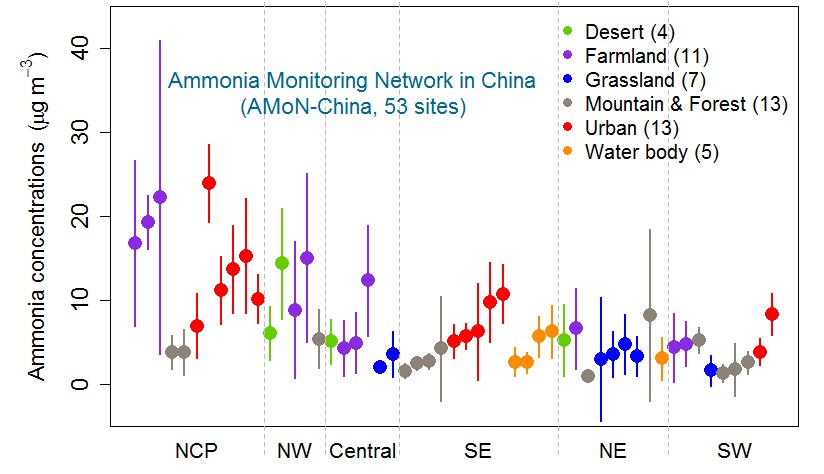The limited availability of ammonia (NH3) measurements is currently a barrier to understanding the vital role of NH3 in secondary aerosol formation during haze pollution events and prevents a full assessment of the atmospheric deposition of reactive nitrogen. Some experiments have been carried out to measure the NH3 concentration across China, but most of previous measurements were limited to few sites or used inconsistent techniques, resulting in difficulties in capturing a comprehensive view over China.
For large-scale surveys of NH3 variability across China, Dr. PAN Yuepeng from Prof. WANG Yuesi’s team in the Institute of Atmospheric Physics (IAP), Chinese Academy of Sciences, implemented a passive NH3 monitoring network based on the diffusive technique with monthly integrated measurements at 53 sites, starting in September 2015. The current Ammonia Monitoring Network in China (AMoN-China) was established mainly based on the Chinese Ecosystem Research Network (CERN, http://www.cern.ac.cn/0index/index.asp) and the Regional Atmospheric Deposition Observation Network in North China Plain (READ-NCP) operated by IAP since 2007.

Atmospheric ammonia concentrations among different regions and land use types, as observed by Ammonia Monitoring Network in China (AMoN-China). (Image by PAN Yuepeng)
In a recent publication in Environmental Science & Technology, the team presented the spatial distributions and seasonal variations in atmospheric NH3 on a national scale in China. Based on a 1-year round observation campaign at 53 sites with uniform protocols, they confirm that abundant concentrations of NH3 [1 to 23.9 μg m−3] were spotted in typical agricultural regions, especially in the North China Plain (NCP). The spatial pattern of the NH3 surface concentration was generally similar to those of the Infrared Atmospheric Sounding Interferometer (IASI) column concentrations as well as a bottom-up agriculture NH3 emission inventory. However, observed NH3 concentrations at urban and desert sites were comparable with those from agricultural sites and 2-3 times those of mountainous/forest/grassland/waterbody sites. They also found that NH3 deposition fluxes at urban sites account for only half of the emissions in the NCP, suggesting the transport of urban NH3 emissions to downwind areas.
"I hope our findings provide policy makers with insights into the potential mitigation of non-agricultural NH3 sources in developed regions." Says Dr. PAN.
This work was supported by the National Key Research and Development Program of China (2017YFC0210100) and the National Natural Science Foundation of China (41405144).
Reference:
Yuepeng Pan, Shili Tian, Yuanhong Zhao, Lin Zhang, Xiaying Zhu, Jian Gao, Wei Huang, Yanbo Zhou, Yu Song, Qiang Zhang, and Yuesi Wang. 2018. Identifying ammonia hotspots in China using a national observation network. Environmental Science & Technology. DOI: 10.1021/acs.est.7b05235, https://pubs.acs.org/doi/pdfplus/10.1021/acs.est.7b05235
Media Contact: Ms. LIN Zheng, jennylin@mail.iap.ac.cn